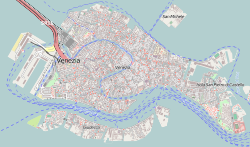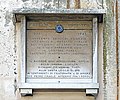| Spanish Synagogue | |
|---|---|
 The synagogue façade, from the square of the Ghetto Nuovo, in 2015 | |
| Religion | |
| Affiliation | Orthodox Judaism |
| Rite | |
| Ecclesiastical or organisational status | Synagogue |
| Status | Active |
| Location | |
| Location | Jewish Ghetto, Venice |
| Country | Italy |
Location of the synagogue in Venice | |
| Coordinates | 45°26′41″N12°19′32″E / 45.4448°N 12.3256°E |
| Architecture | |
| Architect | Baldassare Longhena |
| Type | Synagogue architecture |
| Style | Baroque |
| Established | 1555 (as a congregation) |
| Completed | 1580 |
| Materials | Stone |
| [1] | |
The Spanish Synagogue (Italian : Scola Ponentina; or Italian : Sinagoga Scuola Spagnola) is an Orthodox Jewish congregation and synagogue, that is located in the Jewish Ghetto of Venice, Italy. Designed by Baldassare Longhena in the Baroque style, the synagogue was completed in 1580, and it is one of five synagogues that were established in the ghetto. [2] [3]
Contents
The synagogue is open for services from Passover until the end of the High Holiday season.



